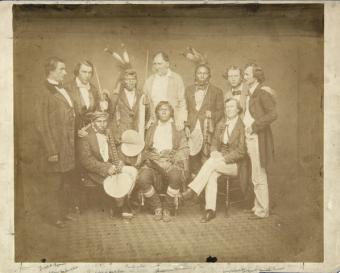A month after Minnesota became the 32nd state in the union, a group of Dakota leaders were summoned to Washington, DC, where they were detained until they signed another treaty relinquishing all land north and east of the Minnesota River to the United States. Dakota title to a 10-by-150-mile strip of land--a portion of the land designated a reservation in 1851--was acknowledged through this treaty. Authority was given to allot individual claims on this reservation land to Dakota farmers. Talking later about his visit to Washington, chief Wapasha, said:
"When I saw our Great Father, I spoke to him about what was my chief desire, which was to have land. The traders were constantly following me for other purposes, and opposing me bitterly; but I paid no attention to them- I shut my ears against them. I only desired to get a title to lands and fix my people so that they could live. I made a treaty at this time, and lands were given to us at Red Wood, on both sides of the Minnesota River. I went home, and lived upon the land, and built houses there. The Great Father told me, before leaving, that he wished us to be well off, but that the whites would endeavor to get this land from us, and that the traders were like rats; that they would use all their endeavors to steal our subsitence, and that if we were wise, we would never sign a paper for anyone. If we did so, he said, we would neve see 10 cents for all our property. I remembered the words of our Great Father and I Knew they were true. I was, consequently, always afraid of the traders."
The people in this photo are; front, from left: Makato, Wabaṡa, Henry Belland. Rear, from left: Joseph R. Brown, Antoine Joseph Campbell, Whale, Andrew Robertson, Red Owl, Thomas Robertson, Nathaniel Brown.
Source: Anderson, Gary Clayton, Woolworth, Alan R. Through Dakota Eyes: Narrative Accounts of the Minnesota Indian War of 1862. St. Paul, MN: Minnesota Historical Society Press, 1988.





